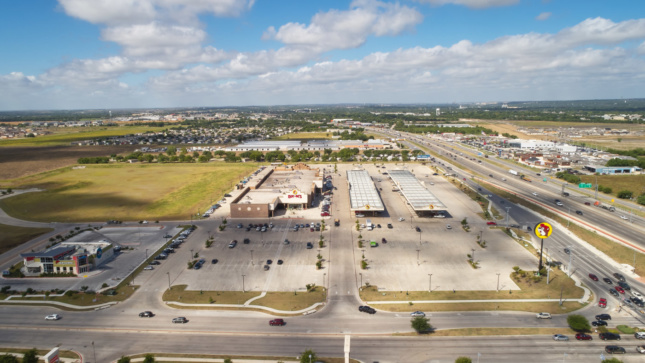Here are some things for sale at Buc-ee’s: dozens of varieties of beef jerky, jalapeño pepper jelly, fudge, yoga pants, gun cases, faux rusticated wood accoutrements, faux rhinestone belts, cowboy art, meaty kolaches, deer corn, American Hunter game feeders, artisan soap, camo tote bags, sports memorabilia, gummy worms, brisket, BBQ smokers, and just about anything else one could possibly want emblazoned with the portrait of the store’s mascot, a cartoon beaver.
For the uninitiated, Buc-ee’s is a Texas gas station chain and so much more. Started in Lake Jackson, outside of Houston, by Arch “Beaver” Aplin III in 1982, the chain now has 33 locations throughout the eastern half of the state. Like a watering hole on the suburban savannah, these mega-size mini-marts serve as a social condenser: They provide a place where the diverse populations of Texas can graze together.

To generate anticipation, Buc-ee’s maintains billboards hundreds of miles out from its stores, inducing in travelers’ minds a yearning for a bathroom break and a bag of “Buc-ee’s nug-ees” before they know their desires themselves. The ads are meme-worthy and infectious: “OMG! It’s a beaver! LOL!,” “My overbite is sexy,” “The Top Two Reasons to Stop at Buc-ee’s: Number 1 and Number 2,” and “Only 262 miles to Buc-ee’s. You can hold it.” They lodge in the brain much like the chain’s corn nug-ees stick in one’s teeth.
Buc-ee’s are big. Full-size versions of the store sport over 100 gas pumps. They are truck stop–scaled attractions with no trucks, as big rigs are not allowed at the chain. The number of pumps makes for an absurdly long shade canopy, as if the plan of a normal gas station was enlarged in one dimension prior to construction. It is a gesture of logistical horizontality, and the form embodies the engulfing flatness of a state that takes 12 hours to cross diagonally. The structure captures the state’s vitality and artificiality; architecturally, Buc-ee’s inspires the same synthetic blend of patriotism and awkwardness as a stretch Hummer.
Some locations include car washes, built with the same strip mall vocabulary as the main building. At the recently opened Buc-ee’s in Katy, the conveyor belt apparatus is 255 feet long and officially set the Guinness World Record for the world’s longest car wash. But there’s an ecological reason for this. According to Aplin, quoted in the Houston Chronicle, the car wash’s length and the number of brushes involved means that it uses less water than smaller operations: “You’re not trying to do it in 50 feet. You have more time…It’s very eco-friendly.”

Inside, the store’s most valuable amenity is its clean restrooms. The bathrooms are immaculately maintained and generously sized, with fully enclosed toilet rooms that are finished, as Kevin Bacon’s character from Tremors might describe it, in tile that goes “all the way up.” After heeding the call of nature, one is immersed in the overwhelming expanse of the retail floor. It feels like a to-go Cracker Barrel on steroids with fewer rocking chairs and more truck nuts. As in a casino, disorientation and interiority dominate the senses. Typically, drink coolers and snack racks are to the right, prepared and fresh food kiosks are in the middle, and hard and soft goods are to the left. Flagship locations are larger than grocery stores, although beyond jams and spices, the stores don’t really sell raw food materials. Square beige tile covers the floors and walls everywhere. Above, the 2×4 pattern of fluorescent lights is a relentless perspectival companion, the grid against which the goods are seen and reflected on every individually packaged unit of merchandise.

Buc-ee’s is big business for its owners and a decent job for its employees. A sign advertises wages for cashiers starting at $14/hour, nearly the $15/hour rate recommended by some progressives as a baseline minimum wage. Municipalities, knowing the chain’s popularity, shell out to land new locations. This year, a Buc-ee’s will open in Denton, where the city agreed to $8.1 million in sales tax reimbursements in exchange for the new 38-acre development. The appeal is legitimate, as each location attracts scores of motorists and generates up to 200 jobs, all contributing to the state’s strong economy.
Buc-ee’s bustles at all hours in its performance of consumer culture. Here, people from all walks of life, about to partake in all kinds of activities, arrive in hot pursuit of sustenance and supplies. Much as Buc-ee’s creates its own network of road trip destinations today, in the early 1970s the Truckstop Network, a project by the briefly Houston-based Ant Farm, reimagined the American freeway system as an infrastructure for “media nomads.” They proposed a set of support modules that would provide essential services for travelers, as well as communication services to allow for the broadcast of original content directly to the public. But now that unlimited streaming is the norm, the mediatized aspect of Ant Farm’s dream feels outdated. What endures are the creature comforts that still spur us to pull over and join the masses in search of junk food and cheap fountain drinks.
In the deserted expanses of roadside America, it is a welcome surprise to suddenly be lost in an air-conditioned crowd as it circulates around a Buc-ee’s interior, swirled along by the currents of individual appetites, only to quickly return to one’s vehicle, as there are no places to sit down, inside or outside. This dance is overseen by the gaze of the eponymous beaver, a ubiquitous character in the store that oscillates between appearing cheery and creepy, depending on one’s mood. The creature’s unblinking eyes peer out from every piece of branded product, its buck-toothed mouth frozen open. If able to speak, what would Buc-ee say?
Despite the store’s appearance of American monoculture, culinary diversity sneaks in; the New Braunfels location offers 37 varieties of jerky, including “bohemian garlic, cherry maple, and ghost pepper,” according to NPR. Like a ten-year high school reunion or an acid trip, Buc-ee’s triggers many surprises about one’s self and the world. As a lovesick essayist wisely observed, “You go to Buc-ee’s for the same reason you break up with someone: to pursue possibility, that narcotic promise of more.”

In Content, OMA described a “social condenser” as a “programmatic layering upon vacant terrain to encourage dynamic coexistence of activities and to generate, through their interference, unprecedented events.” This matches the chaos of Buc-ee’s. It’s not a socialist Narkomfin, where workers might promenade in productive collision after their collective labors, but a capitalist terrain where citizens can stock up on sugared nuts, psychedelic beaver socks, and signs that read, “The most important kitchen utensil is the corkscrew.” Buc-ee’s may not be the social condenser we need, but it’s the social condenser that shows us everything we didn’t know we always wanted.











